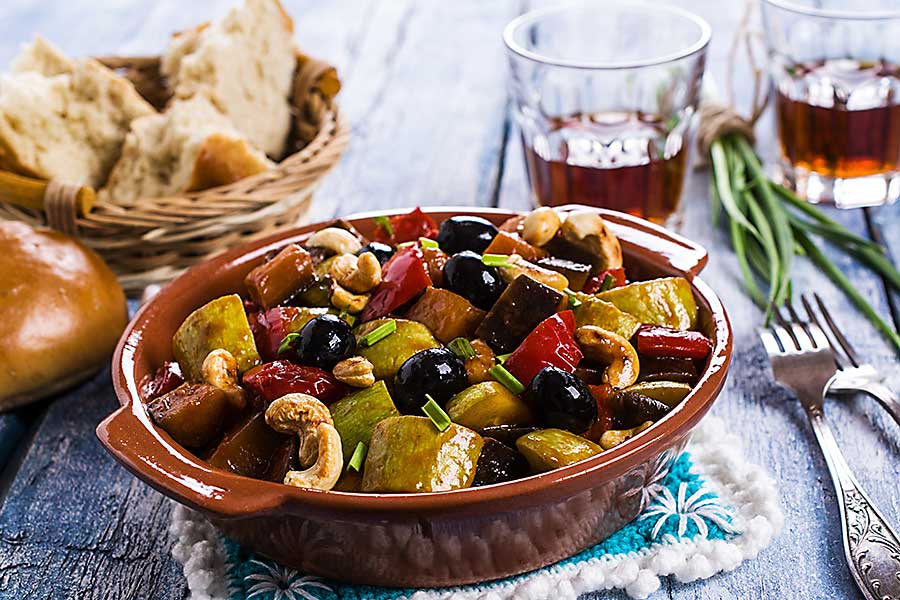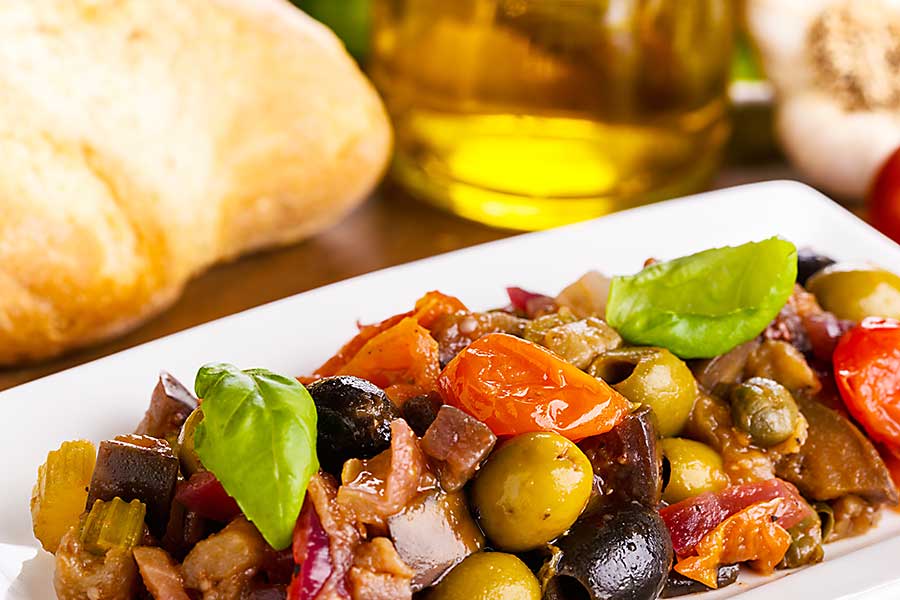Caponata
Caponata is an Italian dish from Sicily, made from stewed eggplant in a sweet and sour broth. The basic foundation of a Sicilian caponata is a vegetable salad made from chopped fried eggplant and celery. The salad is dressed with a sweetened vinegar in a sweet and sour sauce. The sauce or goulash of a caponata is always sweet and sour in flavour, giving the dish a characteristic flavour that makes it easily distinguishable. Caponata is served at room temperature – or barely warm – rather than hot.
Different varieties of caponata
There are at least 30 differing varieties of caponata that are known to be popular, with varying ingredients. There are also innumerable lesser known local versions of the dish. It has been stated that “there are as many ways to make caponata as there are cooks in Sicily”, and that “in every house and in every restaurant you will find a different version and opinion”. Besides eggplant – an undisputed must-have in caponata recipes – the other two ingredients you’ll find in most variations are onion and celery.
Other variations of caponata are known to include zucchini, carrots, fennel, olives, raisins, capsicums, potatoes, and pine nuts. In Palermo, there is a regional variety that adds octopus to the salad. Amongst Sicilian aristocrats, a popular recipe includes swordfish and lobster, garnished with wild asparagus, dried grated tuna roe, and shrimp. The last two recipes, whilst well known, are exceptions to the rule of a sweet and sour flavoured caponata.
Besides the main ingredients listed above, tomatoes or passata are a mainstay in making the caponata sauce. To add the sweet and sour notes, more ingredients are added. Saltiness can come from olives, capers, or anchovies. Sweetness from sugar, sultanas, or raisins. The sour element brings balance and is usually a vinegar or lemon juice addition. The dish is garnished differently depending on the local varieties. Some finish the caponata off with parsley, others with mint, and some others more with basil. Each herb brings a different element to the dish. Flaked almonds, pine nuts, or croutons are other garnishes that can be found on a caponata.
How to serve caponata
Caponata is most often served at room temperature, or barely warm. It is rarely served hot. The dish is often presented as a salad, appetiser, or side dish. It can be served with crostini, with rice, or on its own. In the 18th century, caponata was known as a main course. In modern culinary usage, however, caponata is typically served as a side fish for fish. It is also occasionally eaten as an appetiser.
How to make caponata
With so many varieties of caponata, it is easy to make this dish your own while sticking to the basics of eggplants in a sweet and sour sauce. The eggplants are usually salted and left for around half an hour. They are then shallow or deep fried in olive oil before being mixed with the rest of the vegetables. Some chefs call for caponata to be stewed for half an hour, others for 5-10 minutes. Some even call for the dish to be not cooked at all, instead left to infuse on its own for two hours. The longer a caponata sits before being served, the deeper and more intense the flavour.
Private Chefs, Art of Dining
CHEFIN is a private chef platform that’s reimagining social dining.
You can easily connect with 1 of our 250 private chefs and treat your guests to restaurant-quality dining experiences in the comfort of your own home, office or chosen venue. From high-end dining to quirky social food experiences, the CHEFIN platform makes it effortless for you to access gourmet food that’s worthy of a Michelin-starred establishment.
What you get:
-
- Your very own private chef who is vetted and insured,
- A customised menu for your needs,
- 24/7 concierge support,
- Complete post-dinner cleanup,
- A fun, stress-free, and unforgettably dining experience!


